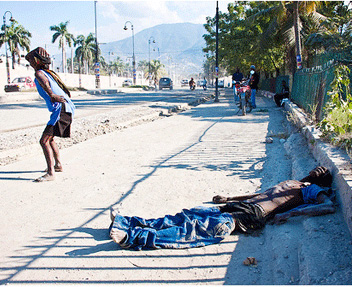
|  |  |  Editorials | Issues Editorials | Issues  
Haiti: Behind the Cholera Epidemic
 Haiti Grassroots Watch Haiti Grassroots Watch
go to original
December 30, 2010


| | Killed by cholera? Or by the lack of clean water and sanitation? Photo taken from the "On The Goatpath" blog entry that documents how victims are buried in mass graves. |  |
This is an emergency.

Cholera is killing at least one person every 30 minutes in Haiti.

Over 2,000 people, and probably many more, succumbed to cholera during the first six weeks of the epidemic. Almost 100,000 people reached hospitals, but countless others never made it due to the country’s abysmal roads and lack of adequate health centers. On Dec. 17, the offical number of dead stood at 2,535, with a 2 percent fatality rate.

But in the Grande Anse, fatality is more like 12 percent. Sick people there are carried on a piece of plywood for up to four hours to the one clinic by groups of men, the victims’s diarreah and vomit running off the plank and onto the bearers and the paths, infecting new communities along the way.

Near the capital, a giant, unlined, uncovered “excreta pool” [front page of this dossier] contains thousands of gallons of feces, some of it likely infected with cholera. The pool a mile or so from the Bay of Port-au-Prince, and on top of the Plaine de Cul de Sac aquifer.

Anywhere from 200,000 to up to a million people will get the illness – and thousands will die – before cholera is eradicated, or rather, if it is eradicated.

Hasn’t this been covered already?

Many news reports have covered the outbreak already.

They’ve investigated who brought cholera to the Haiti. They’ve discussed how cholera is “ravaging” the country, written countless stories about elections, protests, and other events all “in the time of cholera,” in the “beleagured” and “stricken” Haiti. This piece on Palin jammed both adjectives into the title, saying she visited “earthquake-ravaged, cholera-striken Haiti.” The use of the passive voice makes it seem as though these ravages and strikes happen all on their own, like a lightening bolt.

But they don’t.

And not all Haitians face the same risks. Cholera is a disease of the poor, of the disenfranchised. Poor people in poor countries. Cholera thrives where there is no clean water, where there is inadequate sanitation, where there are poor health systems.

While it’s now clear that UN soldiers likely brought Vibrio cholera to Haiti, and while it is also clear that good health care, access to a clean water and sanitation, good hygiene practices and a vaccine can keep it at bay, it’s not clear how to achieve all of that before many thousands more die.

And even if cholera is beaten, dozens of other waterborne diseases threaten Haiti. According to the World Health organization, every year 1.4 million people die from waterborne diseases – about four per minute – most as a result of unsafe and inadequate water and sanitation.

Haiti Grassroots Watch decided to dig into the why and the how of Haiti’s “ravaged” and “striken” situation and asked

Why has cholera taken hold so easily?

Why don’t Haitians have access to clean water and adequate sanitation?

And if all $164 million the UN is seeking is rounded up and cholera eradicated, what will keep another water-borne disease from sweeping ghrough the country?

• • •

Also Read:

Behind the Cholera Epidemic: Excreta
Behind the Cholera Epidemic: The Water Problem
Haiti: From Emergency to Self-Sufficiency? |

 |
|  |



